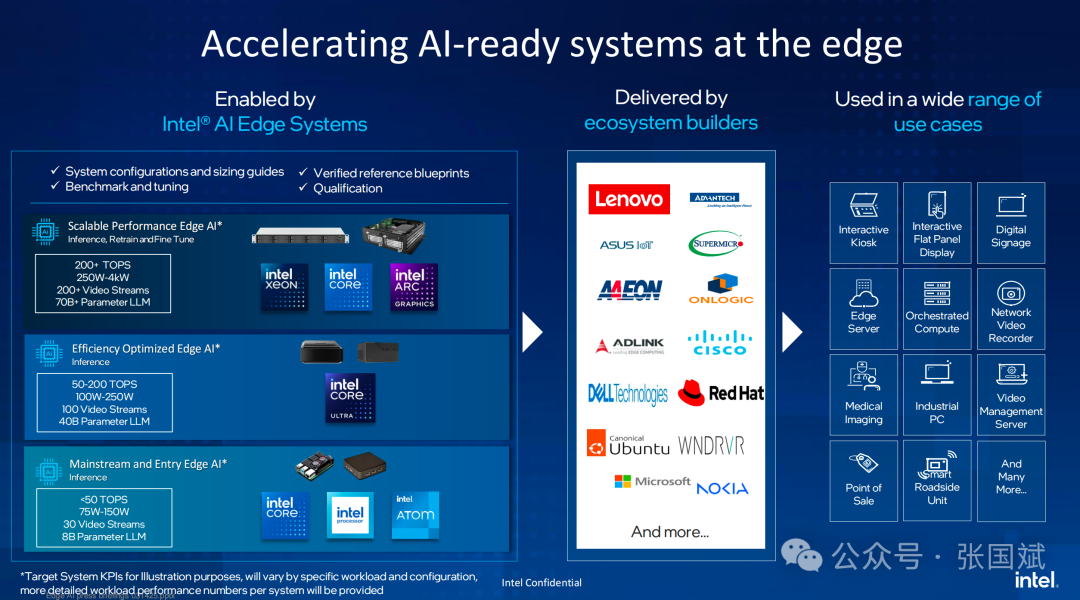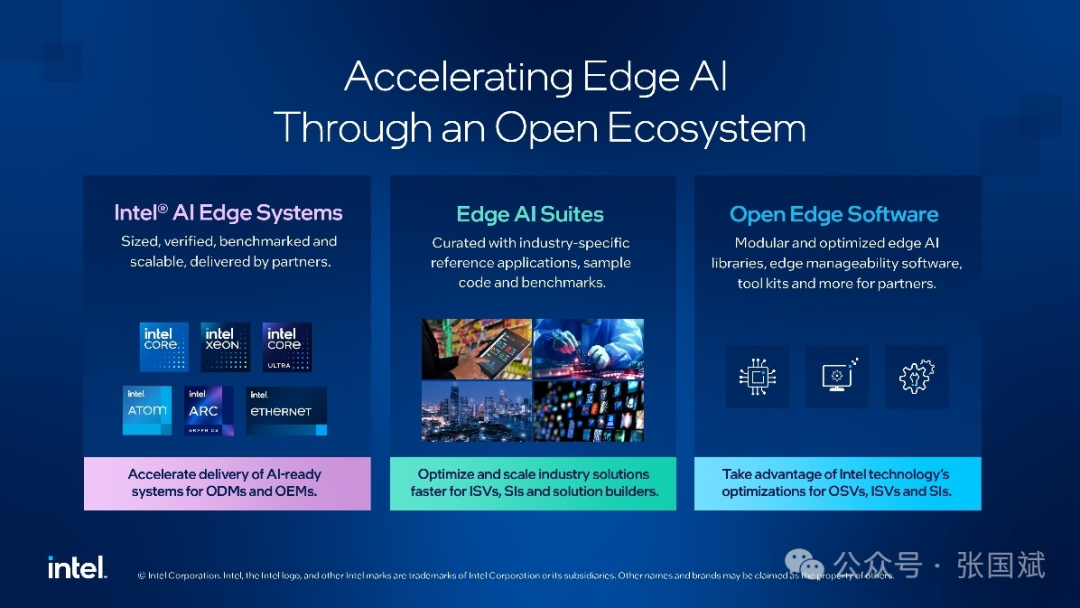In the global wave of digital transformation, edge AI is becoming the core engine for enterprises to break through efficiency bottlenecks. Facing Gartner’s prediction that “by 2025, half of enterprise data will be processed at the edge,” Intel is leveraging an “open ecosystem + full-stack solutions” strategy to launch three innovative products: AI edge systems, edge AI suites, and open edge platforms, collaborating with over 20 leading global companies to build a new intelligent edge ecosystem.
Edge AI Revolution: Breaking Through Technical Pain Points to Achieve Ecological Win-Win
As traditional cloud computing encounters multiple challenges in real-time performance, privacy, and cost efficiency, the rise of edge AI is reshaping the computing landscape. However, enterprises face core pain points such as difficulties in hardware heterogeneous integration, fragmented industry scenarios, and lengthy development and deployment cycles. Leveraging insights from over 100,000 deployments in the edge computing field, Intel has chosen to break through with an open ecosystem strategy—reducing integration costs by 50% through standardized system architecture, shortening development cycles by 30% with open-source toolchains, and achieving cross-industry solution reuse through modular platforms.
Recently, Intel announced the new Intel® AI Edge System, Edge AI Suite, and Open Edge Platform initiatives. By simplifying integration with existing infrastructure, these solutions streamline and accelerate the application of AI at the edge, including deployments in industries such as retail, manufacturing, smart cities, media, and entertainment.
Dan Rodriguez, Vice President and General Manager of Intel’s Edge Computing Division, stated: “Our customers want to expand the application of AI within their existing edge infrastructure and workflows to meet their needs for optimizing TCO, power consumption, and performance. With years of experience in the edge field, Intel has launched the Intel AI Edge System, Edge AI Suite, and Open Edge Software, further enhancing product support for edge AI and accelerating the delivery of AI solutions to the ecosystem.”

Edge AI is becoming an indispensable key component of enterprise innovation. Gartner predicts that by the end of 2025, 50% of the data managed by enterprises will not be stored or processed in traditional data centers or the cloud, but at the edge, such as retail stores, manufacturing plants, and healthcare institutions. By 2026, at least half of edge computing deployments will involve machine learning.
Three Technical Pillars Build the Foundation for Edge AI Innovation
AI Edge System: Breaking the Hardware Heterogeneity Dilemma
Providing pre-validated reference architectures and energy consumption models for scenarios such as retail theft prevention and industrial quality inspection, enabling partners like Lenovo and Supermicro to quickly customize a full range of solutions from 15W micro devices to 200W high-performance servers. For example, the ADLINK DLAP-4100 platform, combined with Core processors and Arc GPUs, reduces video analysis latency to under 50ms.
Edge AI Suite: Digital Packaging of Industry Know-How
The open-source SDK encapsulates algorithm libraries for scenarios such as predictive maintenance in manufacturing and traffic scheduling in smart cities. Wipro has improved its OTNxT industrial platform development efficiency by 40% using this tool. Currently, four major vertical suites cover 80% of mainstream demand scenarios.
Open Edge Platform: The Intelligent Hub for Cloud-Edge Collaboration
Through deep integration with Red Hat OpenShift and Wind River’s software stack, remote management of containerized AI workloads is achieved. Cisco’s tests show that its Xeon 6 SoC architecture platform, combined with this solution, improves lifecycle management efficiency by 60%.
Ecological Fission Effect: From Technical Empowerment to Business Co-Creation
Intel’s open strategy has stimulated collaborative innovation in the industry:
Hardware Layer: Manufacturers like ASUS and Advantech have launched 15 edge AI-specific devices based on standard blueprints within three months.
Software Layer: The integration of Canonical Ubuntu and the OpenVINO toolchain has reduced AI model migration costs by 70%.
Scenario Layer: Nokia’s MX Industrial Edge Platform has integrated generative AI capabilities, creating new business models for predictive maintenance.
“This is not just the delivery of technical solutions, but a reconstruction of the business ecosystem,” emphasized Dan Rodriguez, General Manager of Intel’s Edge Computing Division. As ecosystem partners share a 30% code reuse rate through the open platform, edge AI is evolving from isolated projects into a sustainable digital infrastructure.
Intel and its partners have launched over 100,000 actual edge deployment cases (many of which have adopted AI), deeply understanding the unique challenges involved. These challenges vary by industry, and the requirements for performance and power consumption differ. Solutions suitable for cloud service providers do not apply to edge enterprises, as the latter need to maintain existing platforms and software while integrating AI to achieve excellent TCO and energy efficiency.
Unlike big data centers based on proprietary AI infrastructure, edge AI deployments must seamlessly integrate into existing IT systems and operate in space-constrained, low-power, and cost-sensitive environments.
Based on Intel’s deep technical foundation in the edge field, the Intel AI Edge System, Edge AI Suite software, and Open Edge Platform can effectively address the aforementioned challenges. These solutions also enable the ecosystem to bring edge AI to market faster and more efficiently.
The open edge solutions allow Intel to continuously deliver superior end-to-end performance and TCO across various industries. In edge AI video analysis use cases, relying solely on TOPs does not meet actual performance needs. The Intel® Core™ Ultra processors provide customers with leading end-to-end pipeline performance.
The Future of Intelligent Edge: The Multiplier Effect of an Open Ecosystem
As edge nodes gradually gain autonomous decision-making capabilities, Intel is driving three major trends:
Widespread Adoption of Hybrid Architectures: The Core Ultra processors achieve CPU + GPU + NPU heterogeneous computing, improving energy efficiency by three times.
Generative AI Deployment: Localized operation of large models with 7 billion parameters, achieving response speeds exceeding 200 tokens/second.
Evolution of Autonomous Systems: Through NEXCOM’s software-defined solutions, self-optimizing management of edge nodes is realized.
In this multi-billion-dollar edge intelligence revolution, Intel’s open ecosystem strategy proves that when technological innovation resonates with industrial collaboration, every industry can find its own AI evolution path.
How the Open Ecosystem Accelerates Edge AI: In the context where many edge deployments adopt traditional machine learning and computer vision to integrate AI, Intel’s AI Edge System, Edge AI Suite, and Open Edge Platform software will empower the acceleration of advanced AI application deployments. Through a strong ecosystem composed of trusted partners, Intel is helping enterprises tackle various industry-specific challenges and driving innovation in edge AI deployments.

- Intel AI Edge System The Intel Edge System solution accelerates AI deployment at the edge. Original Equipment Manufacturers (OEMs) and Original Design Manufacturers (ODMs) now have access to standardized blueprints, benchmarks, and validation tools optimized for edge AI use cases. These resources enable customers and solution providers to easily configure systems to meet the performance requirements of use cases such as visual AI or generative AI (GenAI). These solutions come with various energy consumption levels, sizes, and performance options to ensure optimal integration of hardware and software.
- Edge AI Suite: The Edge AI Suite is an open-source, industry-specific AI software development kit (SDK) designed for Independent Software Vendors (ISVs), system integrators, and solution builders. By providing selected reference applications, sample code, and benchmarks, the Edge AI Suite accelerates application development and assists in creating customized edge AI solutions for various industries. Currently, four Edge AI Suites are available, optimized for specific use cases in retail, manufacturing, smart cities, and media and entertainment.
- Open Edge Platform: The Open Edge Platform is a modular open-source platform that simplifies the development, deployment, and management of large-scale edge and AI applications. The platform offers cloud-like ease, allowing independent software vendors, solution builders, and operating system vendors to efficiently build and integrate software components while benefiting from Intel’s latest software optimizations for performance improvements. Partners can efficiently build and deploy containerized workloads on remote edge devices without on-site maintenance, and then manage their deployments using tools like Intel vPro®/Intel® Active Management Technology (Intel® AMT), enabling collaboration and innovation across the entire software ecosystem.
*****Live Broadcast Announcement*******